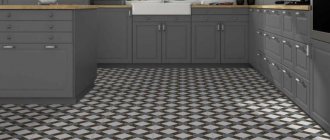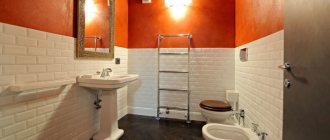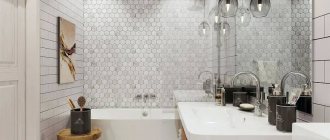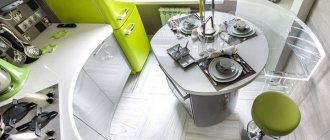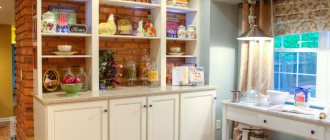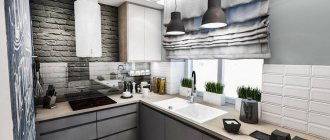It is the tiles that protect the walls from splashes of grease during cooking. Recently, brick masonry has become extremely popular. Today we will tell you how to properly lay hog tiles on a kitchen backsplash, and all the intricacies of this process.
In fact, the apron is one of the most vulnerable parts of the work area. An alternative to the “hog” is tempered glass - skinali, other ceramic tiles and even artificial stone. The choice is often made depending on one’s own preferences and the specifics of the interior design.
Main dimensions of hog tiles
Kabanchik is a rectangular ceramic tile that resembles a brick.
Initially, it was used for cladding buildings, then it migrated to the walls of the subway, which is why in the USA and Great Britain it is called “subway”. The boar has three main sizes:
- small 7.5x10 cm;
- large 10x20 (10x30) cm;
- large 28.5x8.5 cm.
Since large tiles visually make small-sized kitchens smaller, a standard size of 10x20 cm is used for them. Any product is suitable for spacious rooms.
The master's work is afraid
Laying such demanding tiles as “hog” requires experience and some ingenuity. Therefore, to get a good result, we advise you to invite a good tiler. In addition, it is necessary to strictly follow the technology for laying ceramic tiles and use only certified materials: putties, primers, tile adhesives and grouts. Don’t skimp on high-quality finishing materials, then you won’t have to regret wasted money and time.
Don’t be afraid of the difficulties of installing a “hog”, because all of them can be overcome, and the result is so good that over time you will forget about them and admire the beautiful design of your room.
Types of hog tiles
A distinctive feature of the hog is the chamfers - beveled edges running along the perimeter.
With chamfer
Chamfers (or facets) add volume to the product. The glazed surface looks especially impressive with them.
The photo shows a kitchen in chocolate shades, tiled with convex tiles with bevels.
Without chamfer
Flat products without a chamfer look laconic and are used if you do not want to overload the space with relief textures.
How to properly prepare the surface
Before installation, you should carefully inspect the walls for any unnecessary remnants of plaster or old paint. They must be cleaned to avoid peeling when exposed to adhesive under the tiles. The walls must be puttied and primed.
Possessing significant weight and a fairly large thickness, the tiles require application of an adhesive composition to the wall surface along with its application to the tile base.
Only in this case is the required adhesion coefficient and, as a consequence, long service life achieved.
Tile backsplash color
Since the demand for boar is great, manufacturers are producing more and more new types of tiles, using the entire color palette, and also playing with textures, imitating natural materials.
White
This color remains popular due to its versatility. Ideally harmonizes with any shade, does not attract special attention, adding “air”.
The photo shows a kitchen with a white apron, originally located on the lower part of the wall.
Black
A deep black splashback is a bold and incredibly stylish way to highlight your workspace. The dark hog looks luxurious, but has a small drawback: any dirt is clearly visible on its glossy surface.
The photo shows a youth kitchen in which not only the apron is decorated with hog, but also the wall above the doorway.
Blue
Sky or dark blue tiles look original and add freshness to the interior.
Beige
An apron of a neutral shade fits well into a kitchen of pastel (milky, blue) tones. Sometimes it serves as a backdrop for bright furnishings.
Grey
Another universal apron color that is suitable for both light and dark kitchen facades.
Color
Color gives a kitchen its own character. A multi-colored apron will create a unique interior. And red will attract attention and create an atmosphere of hospitality.
Orange
If the kitchen lacks light and comfort, using an orange apron would be a great solution.
Yellow
The sunny yellow color of the apron adds cheerfulness to the interior or serves as a bright accent.
Green
Olive, pistachio, mint, light green – shades of green in the kitchen interior give a feeling of calm and natural harmony, and improve your mood.
The photo shows a kitchen with natural motifs. An olive splashback with a border harmonizes with the natural textures of the countertops and cabinets: marble and wood.
Lilac
This shade is rarely used for hog tiles. The lilac color gives the kitchen not only tenderness, but also uniqueness.
Manufacturers
Modern versions of kabanchik (subway) tiles are usually sold in trade organizations under their own names, which were named by the manufacturers. There are a lot of options on sale with different sizes and shapes of surface relief. The main feature remains only the aspect ratio - 1:2, which allows you to create the correct cladding patterns.
Among the most popular manufacturers from the budget sector are:
- Cersanit. A Polish enterprise that launched production in Russia in 2010. The assortment includes different types of tiles, including boar-type models, monochrome or with various thematic “kitchen” patterns;
- Estima. Russian enterprise established in 2001. The boar model is only a very small part of the total production volume;
- Jade Pottery . Another Russian manufacturer producing high-quality products on Spanish and Italian production lines. About 10% of the entire range of retail chains is supplied by this manufacturer. The quality of the tiles is practically not inferior to European standards.
Manufacturers supplying material at an average price level:
- Vitra. Turkish company operating since 1991. We produce high-quality products that are known in all countries of the world. The assortment also includes boar tile models;
- Creto. Russian manufacturer of ceramic tiles. There are two lines of hog tiles, with imitation of natural materials (wood and stone);
- Kerama Marazzi . A joint Russian-Italian enterprise operating since 1988 on the initiative of the Italian side. Today there are three factories in Russia that produce a wide range of different types of cladding. There are several lines of boar tiles, although only one series has a standard aspect ratio.
Companies whose products can be classified as top-notch:
- Ragno. A manufacturer from Italy, whose products appeared on the market back in 1949. Among the boar-type tile models, we can highlight the WOODESSENCE line with a non-standard aspect ratio (width 100 mm, length 700 mm). Cost 1m2 - from 3600 rubles;
- Italon. Italian company, part of the Atlas Concorde group. Since 2006, the Russian branch has been operating with production facilities in Stupino. A large volume of products is produced, including two model lines of hog tiles. The cost of 1m2 starts from 2580 rubles;
- Carmen. A Spanish company that is part of the APE CERAMICA production holding. The company's assortment, in addition to other products, includes 4 model lines of boar tiles. The cost of 1 m2 starts from 3,500 rubles, but the quality of the material is very high.
Only some manufacturers are listed. The assortment of specialized stores includes products from a huge number of domestic and foreign companies that have high quality and external characteristics. However, it is not advisable to select a material only by the name of the manufacturer. First of all, you should consider its parameters - aspect ratio, color, and other indicators.
Apron design
A kitchen apron, lined with a hog pattern, can stretch along a corner or occupy the entire wall. Depending on the area allocated for it, various types of coatings and additional decor are selected.
If the set occupies the entire wall, it is recommended to use glazed products. The glossy finish effectively reflects light, visually expanding the space.
Hog with a matte finish is less common. It is used in interiors where gloss is stylistically inappropriate, or in kitchens with an abundance of shiny surfaces.
The photo shows a black kitchen, the glossy apron of which is favorably illuminated by built-in lamps.
The hog can easily be combined with other tiles, for example, when you need to highlight the area between the stove and the hood. The mosaic, inscribed in the apron with a thin strip, looks harmonious.
The photo shows a small kitchen, decorated with an emerald-colored apron and patterned tiles in the stove area.
You can also combine different colors and layout methods.
The advantages of such material
Boar tiles are perfect for a kitchen backsplash. This is due to many advantages of the material:
- Excellent sanitary and hygienic qualities. There is no accumulation or development of microorganisms, and thanks to the solid structure without pores, the tiles do not accumulate dirt, which makes them easy to clean.
- A varied selection of colors and pattern textures. In addition, it can be produced to order, decorated with an individual drawing or photograph. Therefore, the hog fits most interior styles.
- High temperature resistance. When making it, firing is used at about 1000 °C, so the tile is definitely not afraid of elevated temperatures from the stove.
- Simple installation technology that does not require expensive tools.
- The material is harmless and environmentally friendly , does not emit gases and does not cause allergies.
Boar tiles have almost no disadvantages. The only thing that can be noted is the relatively high price and low impact resistance.
Photo of tiles with a pattern
There are products, like regular tiles, that imitate natural textures: marble, brick.
A boar with an ornament, pattern or inscriptions is often found in the Scandinavian or Provence style.
Which grout should I choose for backsplash tiles?
First of all, it is worth considering its composition: grout based on epoxy resins, which is resistant to dirt, is best suited for the kitchen. If we talk about the palette, then for a plain neutral backsplash it is recommended to choose a grout that is similar in color to the tile itself. White and gray grout are considered universal.
The photo shows a burgundy-colored apron with matching grout, which “dissolves” the seams without focusing attention on them.
If you need to make an accent apron, you can use contrasting combinations. For example, black grout on white tiles will add a graphic touch to the interior. If the tiles are dark, white joints will highlight the texture or interesting shade.
The photo shows an example of contrasting grout. Without it, the wall above the work area would look empty and unfinished.
Offers from the Leroy Merlin store
When it comes to where it is preferable to buy hog tiles for bathroom decoration, it is worth getting a sufficient amount of information about bona fide manufacturers and sellers who can really offer products of adequate quality. Of course, cheap options may raise justifiable doubts.
You can purchase boar tiles for decorating a bathroom in Leroy Merlin by reading the product catalog. There is a huge selection of tile products that can be used to decorate floors and walls in bathrooms. The company offers a variety of room decoration designs to choose from.
Note!
- Mosaic from broken tiles: step-by-step instructions on how to lay it out with your own hands (140 photo ideas)
Mosaic for the bathroom: TOP-150 photos of new designs, as well as modern ideas for combining mosaic tiles
- Do-it-yourself water heated floor under tiles step by step: installation instructions with photos and descriptions, installation and connection
The variety and quality of the product are factors that largely determine your own choice, based on your personal perception of beauty, taking into account your established budget.
You need to choose taking into account:
- Invoices. The glossy surface is quite slippery and is not suitable for the floor, but the wall looks good in any design;
- Dimensions. Large format - for the floor, then there are fewer seams. Separate patterned tile details and border decorations fit harmoniously;
- Design decision. Patterns and colors are selected only based on personal taste preferences.
Boar tile layout options
If you use plastic panels that imitate a hog, there will be only two cladding options: vertical and horizontal. But the rectangular shape of the individual tile elements allows you to lay it in several ways:
- Vertical with offset. A method by which you can visually lengthen a tiled wall.
- Horizontal staggering. The most common option is when the tiles are laid offset, like a brick.
- Horizontal stackable. A neat seam-to-seam method with an emphasis on geometric accuracy.
- Vertical stackable. A method designed to emphasize the severity of lines in the interior.
- Diagonally. The elements are placed at an angle of 45°. This option is suitable for small kitchens, as it visually expands the apron area.
- Herringbone. The tiles are laid in a zigzag pattern to create a beautiful pattern.
The photo shows a black vertical hog, adding respectability to the interior.
Styling Basics
Laying tiles correctly, especially if they have a bevel, can be a challenge. But, if you have a certain patience, tools and minimal knowledge, you will be able to do everything yourself. The main thing is to make all the calculations correctly, distribute your own forces and be prepared for certain difficulties.
Preparing the base
Any tile, and the hog is no exception, requires appropriate preparation of the walls. This nuance should be given special attention, since the final result depends on it.
Some craftsmen prefer to “level” minimal differences in the plane with tile adhesive, which is quite fair for deviations from the plane of 1–2 mm. In all other cases, it is recommended to use cement-sand plaster.
Before each stage of work, be it leveling or gluing tiles, it is always necessary to degrease and prime the base. This will significantly increase the adhesion of the wall and ensure a high-quality installation of the “hog”. If the rough coating consists of smooth concrete surfaces, ideally it is advisable to additionally treat the concrete with contact.
How to lay in corners
The plate format already initially involves making many cuts during the laying process. The main inconvenience is the chamfer, which makes it difficult to trim evenly. It is necessary to pay attention to even corners and high-quality joints.
Most craftsmen prefer to cut cuts at 45 degrees, which entails high costs for the customer. That is why it is ideal if there are as few joints of this kind as possible.
It is very inconvenient to place the “hog” in corners, both internal and external. Typically, in such places, regular tile trimming is carried out. The end can be further processed, for example, with ordinary fine sandpaper.
Next, the tiles are unfolded so that the cutting falls inside the row, and the entire edge is directed into the corner. This will make the junction of two vertical surfaces perfectly smooth and clear. If the “hog” is without a chamfer, the work will be even easier to complete. Especially when it comes to the external corner for which the bevel is being made.
Laying technology
There are different ways to stick a “hog”, but the most popular is the “staggered” option. In addition, some designers order styling with a side-by-side offset of 20–50% or in a herringbone pattern.
One of the conditions for successful completion of the work is maintaining the same distance between each plate. Otherwise, there is a possibility that the horizontal will shift, which will make the end result, to put it mildly, uninteresting in principle.
When choosing a tile with a chamfer, it is worth considering that it requires special care when making a seam. The volume of the plates attracts quite a lot of attention, which is why all the flaws and nuances become very noticeable.
The seam must be made perfectly even, as thin as possible, regardless of the method of laying the “hog” and the color of the selected grout mixture. It is advisable to discuss all these points with the master before starting work.
You immediately need to understand which crosses for tiles are best suited. Actually, they set the width of the seam.
With traditional classic tiles, it is considered quite normal to choose a cross of 2–5 mm, which allows you to hide any inaccuracies and errors using jointing, but in the case of a “hog” this is unacceptable. This kind of plate looks ideal with a seam of up to 1.5 mm. That is why no mistakes should be made here.
Calculation and marking of vertical rows
Since the “hog” has a specific profile, it is recommended that before installation you consider the issue of its placement on the wall.
If you plan to “stick” the plates only on the apron, then it is desirable that the furniture adjacent to them should be on the flat part, and not on the chamfer.
The situation is similar with the baseboard, in the case of laying tiles to the floor. Otherwise, the “hog” will look bad due to the loose fit of objects or baseboards, as well as the appearance of noticeable gaps.
That is why, before laying the tiles, you need to make an accurate calculation of the placement of the first row, as well as the total number of plates. Typically, craftsmen are additionally given a laying diagram for their work. Knowing what thickness crosses for tiles will be used and the size of the plates, it is possible to complete the task with a minimum error of up to 1 mm.
Note that making any adjustments on paper is much easier than doing it while working on the wall.
How does a boar apron look in different interior styles?
Hog tiles are so multifunctional that they will fit into any interior.
Provence (“French country”) combines rustic simplicity and sophistication. The apron can have a pattern or, conversely, act as a backdrop for cozy little things and an antique set.
White tiles will fit into a spacious loft with rough textures, which will serve as a contrast to industrial furniture. An interesting option is when the smooth glossy coating of the apron echoes the textured brickwork.
Due to its laconic shape, the boar will harmoniously fit into both modern and Scandinavian kitchen styles.
The photo shows a kitchen in a modern direction with herringbone tiles.
In the classic style, a beige hog will find its application, highlighting the splendor of a luxurious set and rich decorative elements.
What it is
Boar tile is a type of tiled facing material with a characteristic shape - it retains the proportions of brick. Dimensions can vary - from 75 to 150 mm in width and from 150 to 300 mm in length. Only the aspect ratio (1:2) is maintained, which allows you to create various patterns when laying - from imitation brickwork to more complex and very attractive shapes.
The first appearance of hog tiles was noted at the very beginning of the 20th century. The name of the material was derived from the specifics of the production process - for convenience, the tiles were made twice as thick, and the glazed coating was applied on both sides at once. During laying, the worker separated the briquette in the longitudinal direction, simply splitting it with a pick. For greater accuracy of separation, two longitudinal through holes were made in the end part, which reminded someone of a pork snout. Hence the name “hog”. It has caught on and is still used today, although this material is called that only in our country. Abroad, this tile is called “subway” (in the original, “subway tile”), since this tile was used for cladding subway stations.
The material has long been used mainly for exterior decoration of buildings, cladding interior surfaces in shops and other buildings. Then the fashion for such finishing passed. A new wave of interest in such tiles has arisen quite recently.
The demand for tiles quickly rose to a maximum due to their convenient size - the material turned out to be the best option for finishing bathrooms and kitchen splashbacks.
